Among various adrenaline whitewater rafting, Bhote Koshi is the most popular among rafts, kayaks,s, and canyoning. The destination is gaining popularity all over the world in the past couple of years. Many guests visit Nepal just to experience rafting in Bhote Koshi.
It is a challenging, thrilling, and exciting river trip of short duration. It is technical rafting as the river is steep. The river crushes with a gradient of 80 feet per mile. It means that it is eight times steeper than the Sunkoshi River.
Highlights
- Enjoy natural rafting rapids in Bhotekoshi
- Observe the river ecosystem of the country Nepal
- Enjoy the campfire nights at the bank of the river
- Observe country side lifestyle of Nepalese
- Enjoy the bird watching in the bank of the river
Bhotekoshi River Adventure Activities
Regulus recommends Bhote Koshi Rafting for an intense and thrilling trip in a short duration. Experience one of the world's highest thrilling bungee jump from the Bhotekoshi suspension bridge with a height of 160 m.
Rafting in Bhotekoshi
Nepal is a well-accepted country in the arena of water sports especially, rafting and kayaking. The rivers here are in a natural state to serve the purpose of rafting and kayaking. Bhote Koshi is serving the purpose of thousands of tourists every year with its wilderness and beauty. This river Bhotekoshi originated in the glaciers of Tibet. The site is also famous for its typical flora and fauna. You will enjoy the greenery, landscapes, and gorges on a high-speed and bumpy ride. In other words, rafting in Bhote Koshi River is an experience of lifetime thrill and excitement.
Rafting Rapids Classes
On the basis of complex drops and rapids, the river is divided into three parts upper, middle, and lower.
Best Season For Bhotekoshi River Rafting
The river Bhote Koshi is situated northeast of Kathmandu. It is around four hour drive from the capital city. To get the real flavor of Bhote Koshi rafting, Regulus has designed an itinerary of two days. This will truly make you satisfied. You will cover a distance of 25 kilometers on the river. The best time for Bhote Koshi rafting is September to December and February to mid-March. Water flow is less at this time in comparison to monsoon.
But, if you are an experienced and professional rafter then you can experience rafting throughout the calendar.
The twist and turns in the river make the adventure full of fun. The boulder gardens, waterfalls, and vertical bends are the few obstacles that the kayak has to overcome.








